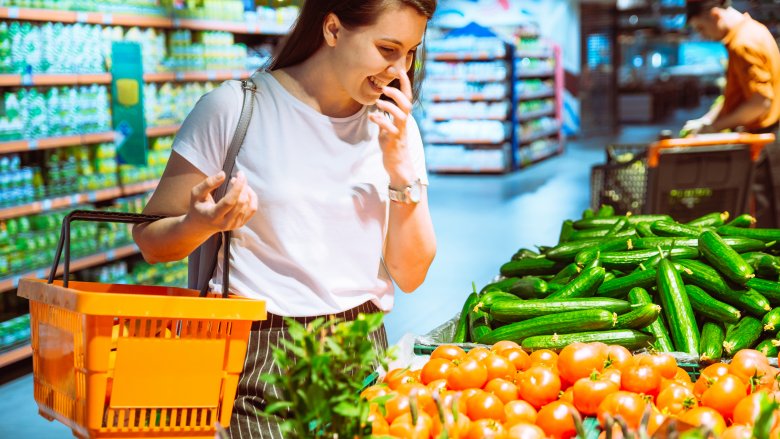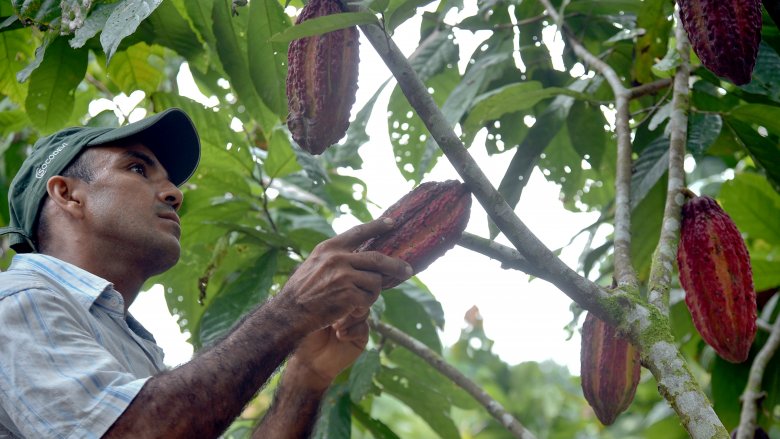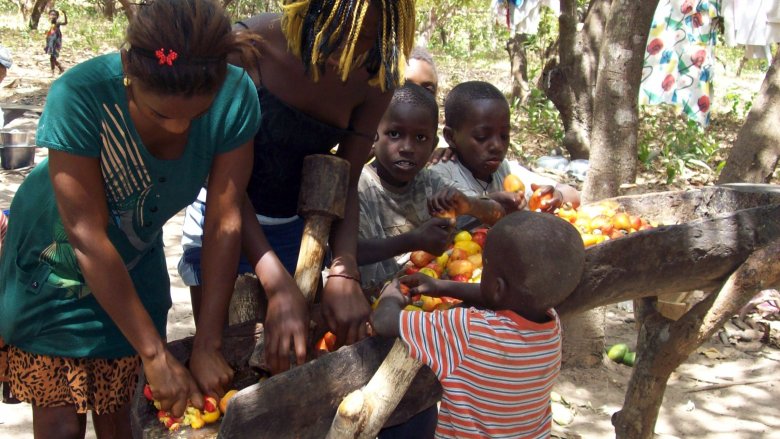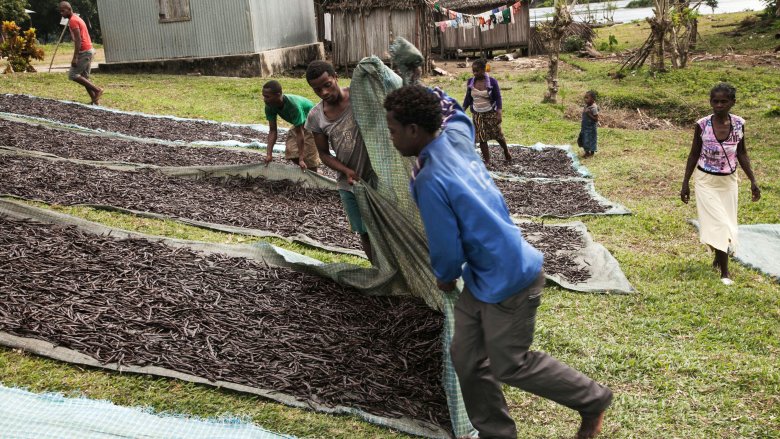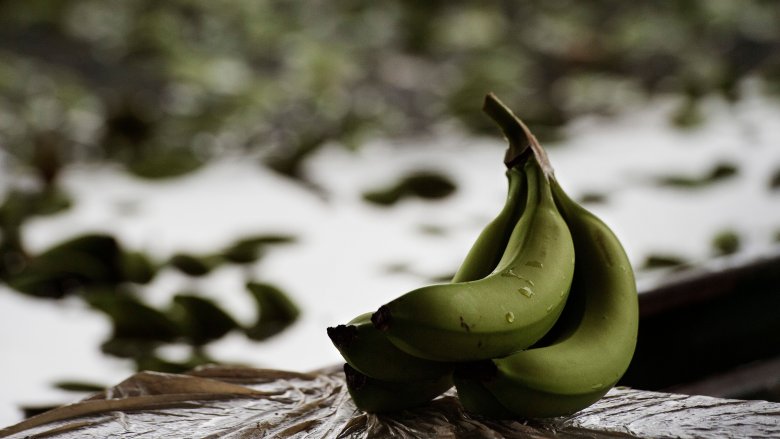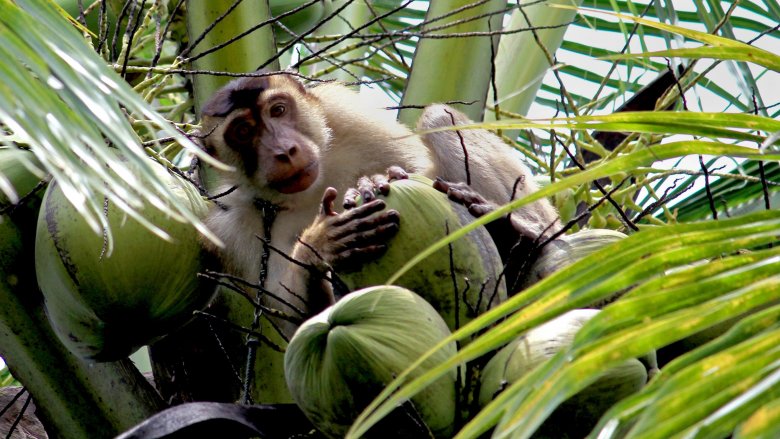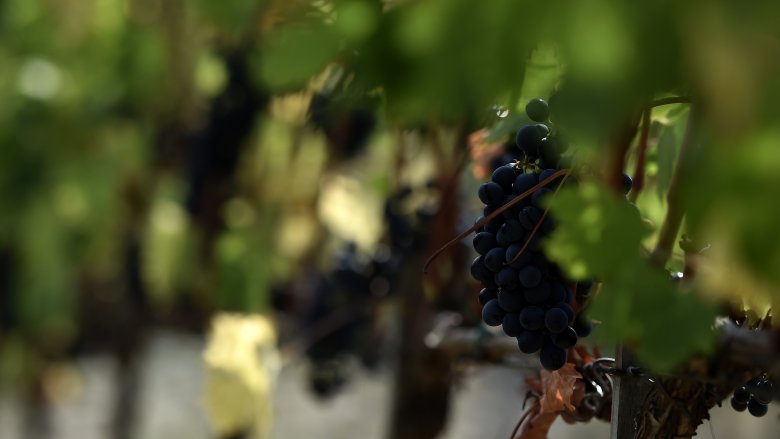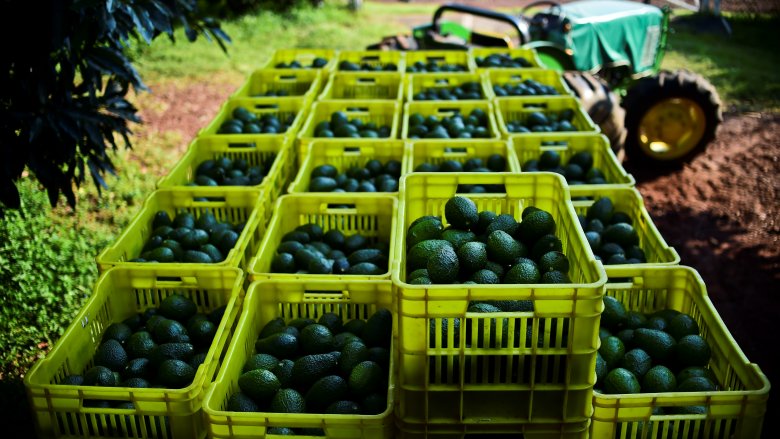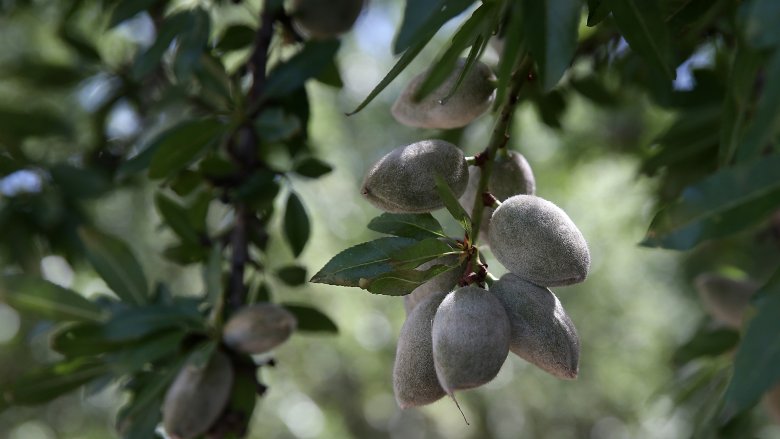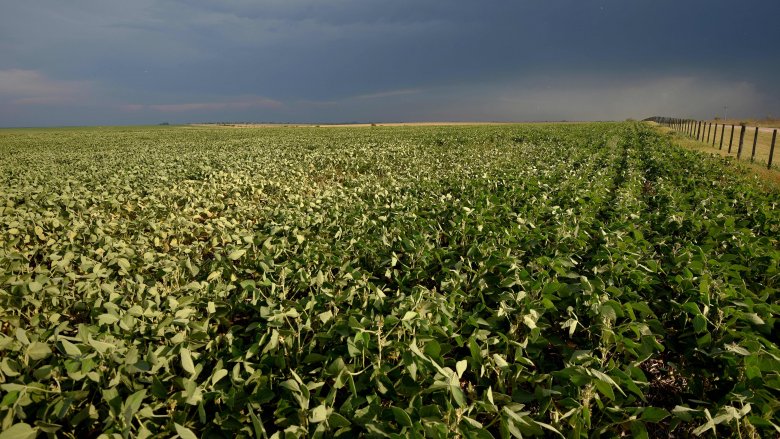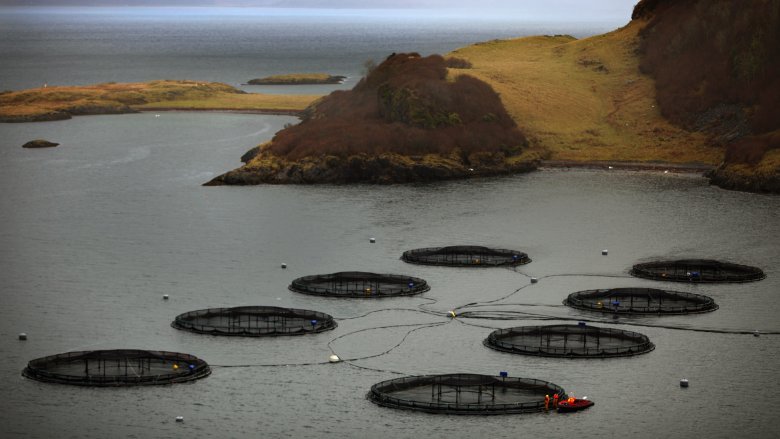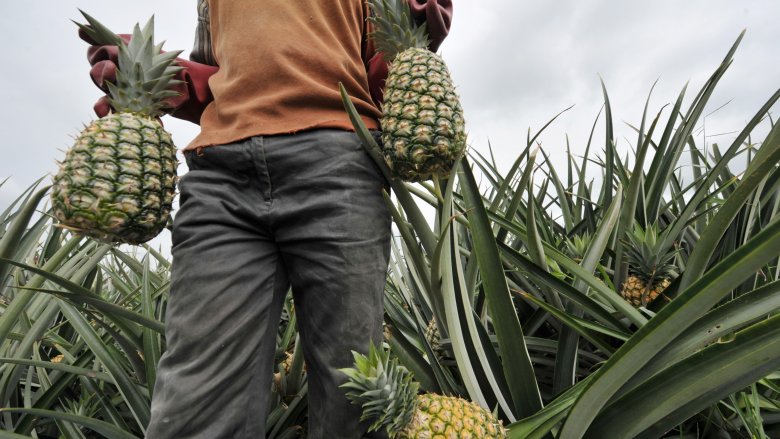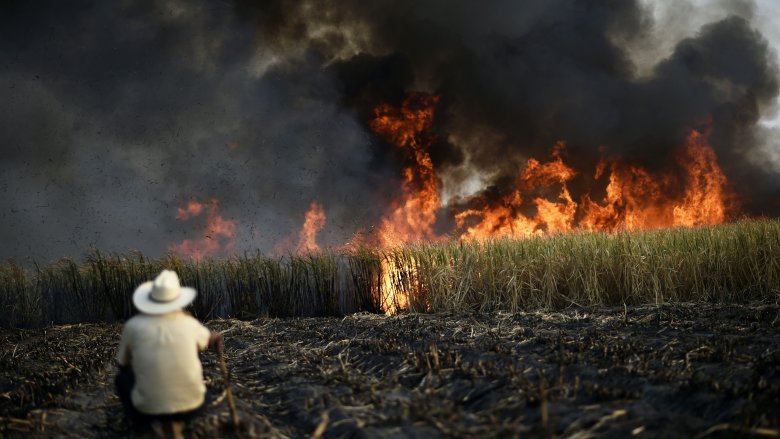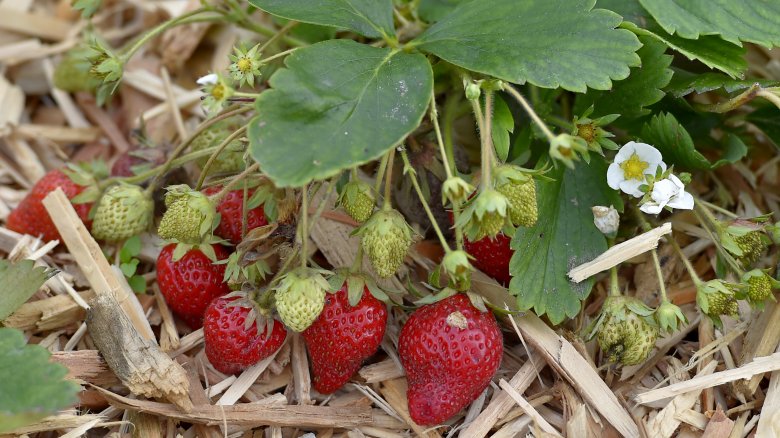Foods You'll Stop Buying Once You Know How They're Grown
Along with the foodie movement has come an increased awareness of where our food comes from and how it's grown. While many restaurants are trying to do a ton of good by getting as many of their ingredients from local growers as they can, that's not always possible for the average consumer. Those of us who head to a grocery store instead of a wholesaler or a farmer can still try to make ethical decisions that are good for our bodies and our wallets, but it's tough.
Do some research into just how some of our favorite foods are grown and harvested, and you'll find some terrible things. We're not just talking about crops that aren't environmentally friendly — although that's certainly part of it — we're talking about crops that are harvested by slave labor, that require so many pesticides and insecticides that they're making entire communities sick, and some that are even the product of animal cruelty. So, let's talk about what you should know — and consider — next time you think about picking up some of these foods and putting them in your cart.
Chocolate
In 2018, a consortium of agencies (including Oxfam and the International Labor Rights Forum) released their Cocoa Barometer. It's a measure of the state of the cocoa industry on an agricultural level, and it's dismal stuff. Not only did falling cocoa prices mean farmers living in poverty saw their profits drop even lower, but there had been little to no success in stopping the widespread use of child labor. They estimated more than 2 million children were working on cocoa plantations in West Africa alone, and that's staggering.
Here are some other numbers. Raconteur says the living wage in Cote d'Ivoire is $2.51 per day. Cocoa farmers can expect to make around 78 cents, and that's where the necessity of child labor comes in. While some chocolate companies — like Tony's — have completely eliminated slave labor in their productions lines, others — like Nestle — are working on it. Nestle implemented the Child Labour Monitoring and Remediation System, in which they're asking farmers to declare the child labor they're using so the community can help stop it. Is that really enough?
Cashews
Everyone loves cashews, but you might not love them nearly as much after you hear about a 2011 expose by the Human Rights Watch (via Time). They found that most of the cashews coming out of Vietnam were processed by some of the 40,000 people being detained in the country's "drug rehabilitation centers," places that were more accurately described as forced labor camps. Detainees were subjected to electric shocks, beatings, starvation, and isolation in solitary confinement, all while performing what's called "labor therapy." One major form of labor therapy, of course, is shelling your cashews.
In 2013, The Guardian reported on the EU's call for an overhaul to worker conditions in cashew factories in India, where things aren't much better. Each cashew has to be hand-shelled, and it's pretty terrible. Taking the shells off a cashew releases a caustic liquid that causes burns, and since many workers can't afford to buy gloves (and often aren't given them), they often suffer permanent scarring and damage to their hands, along with the joint pain and arthritis that also comes with the job. For that, The Telegraph says they earn around $2 per day.
Vanilla
Vanilla is one of the world's most popular flavors, and the good stuff comes from Madagascar. Real vanilla pods cost a surprising amount of money and sadly, according to the research center Danwatch (via The Guardian), the people growing and harvesting the vanilla aren't seeing much of the profits at all.
They see so little of those profits, in fact, that most of the vanilla-growing communities in the Sava region of Madagascar live in heartbreaking poverty, and still rely on child labor to do a lot of the work. The weeks leading up to the harvest are often filled with starvation and uncertainty, with many families forced to take out loans — with astronomical interest — from the "collectors" who ultimately buy their harvests at a fraction of what it's worth on the global market.
The International Labour Organisation estimates there's about 20,000 children employed in the vanilla trade as of 2016, and Tombo Tam Hun Man (who The Guardian describes as a "former mayor and now local vanilla kingpin") describes the necessity of child labor like this: "If you don't start to teach your kids to do something, what will they do? It is better than nothing."
Bananas
Bananas aren't like most fruit, and they're the result of what The Guardian calls "a genetic accident in nature." They're all (nearly) genetically identical, and that means they all have the same exact vulnerabilities to the same exact diseases.
In order to keep banana crops healthy and productive, there are a ton of pesticides used on many (but not all) plantations. The Environmental Working Group estimates there's an average of 35 pounds of pesticide used on every acre of banana trees. It's even administered differently than you might expect: farmers will often put each bunch of bananas into a plastic bag and pump the pesticides directly into it.
Since bananas are peeled before we eat them, the end consumer doesn't have to worry too much about the impacts of those pesticides. There's a big but — the chemicals have been found leaching into the environment and local wildlife, poisoning not only the animals that live near banana plantations but the people who work there, too. The pesticides have also been linked to birth defects and brain damage in the workers and their families, with children living on and around plantations with high pesticide use suffering the most.
Coconuts and coconut oil
Animals are often efficient (and adorable) partners, but unfortunately, the coconut industry sees pig-tailed macaques less as partners and more as slaves, says The Huffington Post.
The monkeys are native to some of the same areas where coconuts grow, and they're very good at picking them. A trained monkey can pick up to 1,000 coconuts a day, and if that seems like a lot, it is — and their lives are brutal and painful.
Baby monkeys are often sourced through poachers, who kill nursing mothers then hand the babies over to plantations and handlers. They're then sent to facilities where they're trained to pick ripe coconuts. When they're not working, they're often kept in solitary cages, or in sheds where they're chained and staked to the ground, allowed only a single perch to sit on. It's unclear just how widespread the practice is, and in spite of the fact that many companies claim to source their coconuts only from plantations that don't use monkeys, NPR spoke to some industry representatives who claim that 99 percent of coconuts from Thailand were picked by macaques. (They also say the practice can be humane, when done correctly.)
Italian wine
In 2015, a 49-year-old woman named Paola Clemente died in the vineyards of Italy. She had a heart attack, reports The New York Times, and her death brought a horrible practice to light: the slave labor behind many Italian wines.
Her death sparked an investigation that resulted in the arrest of six people, accused of transporting and extorting poor women so desperate for work that they would quietly labor under brutal conditions. They were forced to work long hours — some of which, they weren't paid for — while being worked so hard that even in the hot summer months they were afraid to drink water, because they were trying to avoid asking permission to go to the bathroom. Anyone who was late or missed a day wouldn't be offered more work, and according to the investigation, Clemente was often teased because she was so tired and ill she would fall asleep in mid-conversation.
Hers isn't the only death that's come out in recent years, and according to The Independent, tens of thousands of people just like her work 12- and 13 hour days performing back-breaking labor, for an average of about $30 a day.
Avocados
Avocados got really popular, really quickly, and according to the Brown Political Review, Mexico had earned a profit of roughly $2.2 billion from avocados alone by 2016. That seems like it would be a great thing for Mexican avocado farmers, but the skyrocketing popularity of this creamy fruit has also gotten some unwanted attention from drug cartels looking for another source of income.
Some estimates suggest the Los Caballeros Templarios takes in around $150 million a year from avocado growers, and methods are simple. They approach farmers, and simply tell them that if they don't fork over some cash, bad things are going to happen to them, their farms, and their families.
Not all avocado farms are beholden to the cartels, although some estimates suggest they control about 10 percent of Mexico's orchards. Some communities have worked together to kick cartels out, but others are still being forced to produce what's become termed "blood avocados," says Grazia. There are other problems, too. Even as the cartel is burning orchards of farmers who don't pay, water resources are being absorbed into the industry, huge patches of forests are being turned into croplands, and entire species are losing their homes.
Almonds
Most of the world's almonds are grown in California orchards, and according to Forbes, increasing demand means that more and more land is being turned over to almond production. In 2016, they found that — based on satellite images — around 23,000 acres of land had been covered with almond trees. Unfortunately, 16,000 of those acres had once been natural wetlands. At the same time — between 2007 and 2014 — there was a 27 percent increase in irrigation. And, in 2011, California was hit with a catastrophic drought.
Mother Jones says it takes 1.1 gallons of water to grow a single almond, and the impacts of that are far-reaching. They found that farmers in the San Joaquin Valley dug a mind-blowing 2,500 wells in 2015 alone, in spite of the fact that since 2013, the massive amount of underground water extracted and redirected toward crops — particularly almonds — has caused massive patches of sinking land. That's damaged roads, bridges, and other infrastructure, making almonds a delicious, healthy snack with catastrophic consequences.
Soy
Demand for soy products has been on the increase, and according to the World Wildlife Fund, that's come with devastating consequences. Countries that produce an ever-increasing amount of soy — like Argentina, Paraguay, Bolivia, and Brazil — are turning more and more land into soybean plantations.
That's causing a chain reaction of environmental impacts, beginning with the destruction of the natural habitats of species like the jaguar. It's also increasing the amount of soil erosion happening, particularly around bodies of water. Those rivers and lakes are, in addition, growing increasingly polluted by runoff from the massive farms, which are also giving off considerable emissions. When a swath of savannah called the Cerrado was converted into soybeans farms, estimates from the Brazilian government suggest it gave off greenhouse gases equivalent to more than half the UK's total emissions from 2009.
There's social impacts, too. Small farmers are being forced off lands that are being folded into massive commercial farms, workers are being exploited for cheap labor, and native tribes who have lived on the land for generations are being threatened by the relentless deforestation.
Salmon
In 2017, The Guardian reported on a problem that was as disgusting as it was widespread. Salmon farmers were fighting a massive problem: lice.
Steel cages containing farm-raised salmon are ideal breeding grounds for the sea louse, a tiny, many-tentacled creature that survives by attaching itself to fish and eating its way through the salmon's skin. It only takes a few lice to kill a fish, and not only are they widespread, but they spread disease and are resistant to control methods.
Pesticides are used to try to control the lice, and are farmers forced to use antibiotics to stem the spread of disease through fisheries. The immediate consequences are entire bodies of water that are being contaminated with chemicals. British broadcaster Jeremy Paxman has called for (via The Telegraph) a complete overhaul of the salmon industry, including more transparency when it comes to how salmon are raised. Many of the so-called "wild" salmon on the market are actually raised in cages, roughly 130 feet long and holding as many as 70,000 fish. "Salmon has long been sold on the prospect of cleanliness and health," he wrote. "The impression is fraudulent."
Pineapple
When The Guardian interviewed Fernando Ramirez, leading agronomist at the National University's toxic substances institute, he revealed something shocking: in order to grow pineapples, around 44 pounds of pesticides is used for every 2.5 acres, and that's just the start. The soil pineapples are grown in is often sterilized completely, during a series of between 14 and 16 different types of treatment.
It's all perfectly legal in Costa Rica, one of the world's major producers of pineapples. It's only gotten worse, and in order to keep up with demand while keeping costs low, massive plantations have resorted to employing armed guards to watch over crops and workers, making sure everything moves at a swift pace without interference. (There are an estimated 17,000 armed, private-company security guards in Costa Rica alone.)
Those living near pineapple plantations have been forced to abandon traditional water sources in favor of water brought to them in tankers, because of the high levels of cancer-causing chemicals now in groundwater. For many, it's not enough — villages can wait days for safe water, or risk suffering from bone pain, vomiting blood, and blindness in addition to the development of chronic illnesses that come from drinking water polluted by the pineapple industry.
Sugar
The World Wildlife Fund estimates around 145 million tons of sugar is produced annually, and sugarcane causes a whole host of problems, starting with environmental.
Sugarcane is a little different from many crops, they say, as it's in the ground — and absorbing water — almost year-around. A dozen countries devote 25 percent or more of their agricultural land to sugarcane, and the process of getting the land ready for a crop is devastating. All ground cover is stripped, the soil is dried, and that ultimately increases erosion, susceptibility to pollution, and the destruction of entire ecosystems.
Then, there's the widespread practice of burning sugarcane fields before harvesting. In theory, the burns strip away the leaves to make harvesting easier, but according to Earth Justice, it also releases thousands of tons of pollutants into the air. The pollutants aren't just ugly, they're toxic, and have been linked to causing cancer and genetic mutations in those living near plantations that prep harvests this way.
Strawberries
Strawberries are delicious, so delicious the Environmental Working Group reports that on average, a typical American eats about eight pounds of them a year. Unfortunately, strawberries regularly sit at the top of the group's Dirty Dozen list.
In 2015 and 2016, strawberries tested by the Department of Agriculture uncovered an average of 7.8 different types of pesticides on each sample. Around 20 percent of samples had 10 or more pesticides, and the worst offenders came with a shocking 22 different pesticides. Overall, they found 81 different types of chemicals used.
Some of those have been banned in Europe because they've been linked to causing cancer, and here's the thing: Pesticides are applied at an average rate of 300 pounds per acre, and that's not the only kind of chemical that's applied to strawberry crops.
Next, we need to talk about the fumigants. Those are chemicals applied to the dirt to completely sterilize the soil and kill microorganisms before they can kill the strawberry plants, but some of those chemicals were developed as chemical warfare agents. Some are even outlawed under the Geneva Convention. After these fumigants are injected into the soil, farmers cover their fields with tarps to keep the chemicals away from people, but those barriers, unfortunately, don't always work.
In addition to all those chemicals, there's also the human cost. When The Conversation reported on California's strawberry industry, they found widespread problems that included low wages for workers, poor working conditions, and shocking water usage. Delicious, but costly.
